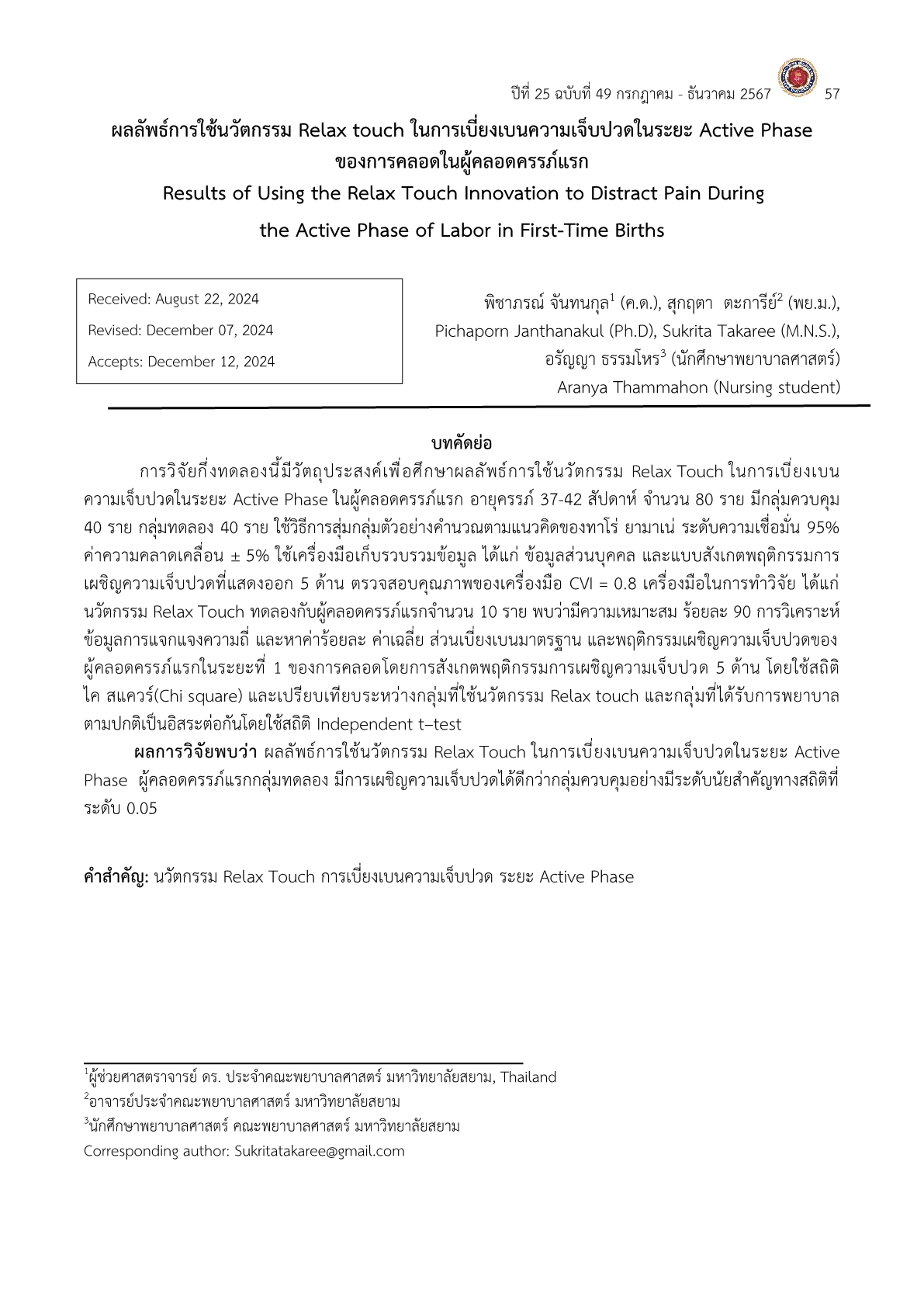ผลลัพธ์การใช้นวัตกรรม Relax touch ในการเบี่ยงเบนความเจ็บปวดในระยะ Active Phase ของการคลอดในผู้คลอดครรภ์แรก
คำสำคัญ:
นวัตกรรม Relax Touch, การเบี่ยงเบนความเจ็บปวด, ระยะ Active phaseบทคัดย่อ
การวิจัยกึ่งทดลองนี้มีวัตถุประสงค์เพื่อศึกษาผลลัพธ์การใช้นวัตกรรม Relax Touch ในการเบี่ยงเบนความเจ็บปวดในระยะ Active Phase ในผู้คลอดครรภ์แรก อายุครรภ์ 37-42 สัปดาห์ จำนวน 80 ราย มีกลุ่มควบคุม 40 ราย กลุ่มทดลอง 40 ราย ใช้วิธีการสุ่มกลุ่มตัวอย่างคำนวณตามแนวคิดของทาโร่ ยามาเน่ ระดับความเชื่อมั่น 95% ค่าความคลาดเคลื่อน ± 5% ใช้เครื่องมือเก็บรวบรวมข้อมูล ได้แก่ ข้อมูลส่วนบุคคล และแบบสังเกตพฤติกรรมการเผชิญความเจ็บปวดที่แสดงออก 5 ด้าน ตรวจสอบคุณภาพของเครื่องมือ CVI = 0.8 เครื่องมือในการทำวิจัย ได้แก่ นวัตกรรม Relax Touch ทดลองกับผู้คลอดครรภ์แรกจำนวน 10 ราย พบว่ามีความเหมาะสม ร้อยละ 90 การวิเคราะห์ข้อมูลการแจกแจงความถี่ และหาค่าร้อยละ ค่าเฉลี่ย ส่วนเบี่ยงเบนมาตรฐาน และพฤติกรรมเผชิญความเจ็บปวดของผู้คลอดครรภ์แรกในระยะที่ 1 ของการคลอดโดยการสังเกตพฤติกรรมการเผชิญความเจ็บปวด 5 ด้าน โดยใช้สถิติไค สแควร์(Chi square) และเปรียบเทียบระหว่างกลุ่มที่ใช้นวัตกรรม Relax touch และกลุ่มที่ได้รับการพยาบาลตามปกติเป็นอิสระต่อกันโดยใช้สถิติ Independent t–test
ผลการวิจัยพบว่า ผลลัพธ์การใช้นวัตกรรม Relax Touch ในการเบี่ยงเบนความเจ็บปวดในระยะ Active Phase ผู้คลอดครรภ์แรกกลุ่มทดลอง มีการเผชิญความเจ็บปวดได้ดีกว่ากลุ่มควบคุมอย่างมีระดับนัยสำคัญทางสถิติที่ระดับ 0.05
เอกสารอ้างอิง
ณัฐญา อัมรินทร์ และ สุทธิ อัมรินทร์. (2564). ผลิตภัณฑ์น้ำมันหอมระเหยจากเปลือกส้ม. วารสารการอาชีวศึกษาภาค กลาง, 5(1), 17-24.
นราภรณ์ ฤทธิเรือง, พิริยา ศุภศรี และสุพิศ ศิริอรุณรัตน์. (2560). ผลของโปรแกรมการสร้างพลังอำนาจต่อการเผชิญความเจ็บปวดในระยะคลอดและรับรู้ประสบการณ์การคลอดของผู้คลอด. วารสารมหาวิทยาลัยนราธิวาสราชนครินทร์, 9(3), 48-56.
เบญจมาภรณ์ ชูช่วย. (2558). ผลของโปรแกรมการสนับสนุนอย่างต่อเนื่องในระยะคลอดโดยพยาบาลต่อระดับความเจ็บปวดและพฤติกรรมการเผชิญความเจ็บปวดในหญิงวัยรุ่นครรภ์แรก. (วิทยานิพนธ์ปริญญามหาบัณฑิตที่ไม่มีการตีพิมพ์). มหาวิทยาลัยสงขลานครินทร์.
ภัทรานิษฐ์ เหมาะทอง, วนิดา ทองโคตร, และสุพรรณี อึ้งปัญสัตวงศ์. (2560). การกำหนดขนาดตัวอย่างโดยใช้สูตร Yamane (Determining the sample size by the Yamane's formula). http://sc2.kku.ac.th/stat/statweb/images/Eventpic/60/Seminar/01 9 Yamane .pdf
มลิวัลย์ รัตยา และอวรรณ ฤทธิ์มนตรี. (2562). พฤติกรรมการเผชิญความเจ็บปวดในระยะคลอดของหญิงตั้งครรภ์วัยรุ่นตอนต้น: แนวคิดและวิธีการจัดการโดยไม่ใช้ยา. วารสารการแพทย์โรงพยาบาลศรีสะเกษ สุรินทร์ บุรีรัมย์, 34(1), 113-126.
เยาวรัตน์ ดุสิตกุล. (2565). ผลของโปรแกรมส่งเสริมการเผชิญการเจ็บครรภ์คลอดต่อระดับความเจ็บปวดและพฤติกรรมการเผชิญความเจ็บปวดของผู้คลอดครรภ์แรก, วารสารการพยาบาล, 1(3), 31-38
เรขา กลลดาเรืองไกร. (2560). Color Therapy ศาสตร์แห่งสีเพื่อการบำบัดโรค. https://goodlifeupdate.com
รัศมี ศรีนนท์, วิมลมาส ติ่งบุญ และอมรรัตน์ สว่างเกตุ. (2565). ผลของการใช้อุปกรณ์นวดต่อระดับความเจ็บปวดของผู้คลอดในระยะปากมดลูกเปิดเร็ว. วารสารสิรินธรปริทรรศน์, 23(1), 376-386.
สุกฤตา ตะการีย์, พิชาภรณ์ จันทนกุล, อรทิพา ส่องศิริ, ธัญลักษณ์วดี ก้อนทอง และธัญญลักษณ์ ดีชาติธนากุล.(2566). ผลการใช้นวัตกรรมนุ่มนิ่มอโรมาคลายเครียดสำหรับนักศึกษาพยาบาล มหาวิทยาลัยสยาม. วารสารพยาบาลสตร์ มหาวิทยาลัยสยาม, 24(46), 69-82.
สุภาพรรณ ทิพย์สัจจะธรรม และไกรสร อัมมวรรธน์. (2559). ผลของโปรแกรมนวดบำบัดด้วยน้ำมันหอมระเหยต่อความเจ็บปวดในการเจ็บครรภ์คลอด. https://grad.dpu.ac.th
แสงอุษณีษ์ นวะมะรัตน. (2561). หลักจิตวิทยาและทัศนธาตุทางศิลปะในการผ่อนคลายความเครียด. (วิทยานิพนธ์ปริญญามหาบัณฑิตที่ไม่มีการตีพิมพ์). มหาวิทยาลัยศิลปากร.
Cumningham, FG.et al (2005). williams obstetrie. (22 th ed.). New York: McGraw-Hill.
Hodnett, E.D. (1996). Nursing support of the laboring woman. Journal of obsteric, Gynecologic, and Neonatal Nursing, 25, 257-264.
Novak, J.C., & Broom, B. L. (2000). Ingalls & Salermo's maternal and child health nursing (9th ed.). St. Louis: W.B. Saunders.
Melzack, R., Wall, (P.D.). (1996). Pain mechanisnas. a new theory. Pain Forum, 5: 3-11.

ดาวน์โหลด
เผยแพร่แล้ว
รูปแบบการอ้างอิง
ฉบับ
ประเภทบทความ
สัญญาอนุญาต
ลิขสิทธิ์ (c) 2024 วารสารพยาบาลศาสตร์ มหาวิทยาลัยสยาม

อนุญาตภายใต้เงื่อนไข Creative Commons Attribution-NonCommercial-NoDerivatives 4.0 International License.
เนื้อหาและข้อมูลที่เผยแพร่ในวารสารพยาบาลศาสตร์ มหาวิทยาลัยสยามถือเป็นข้อคิดเห็นและความรับผิดชอบของผู้นิพนธ์บทความโดยตรง
บทความ เนื้อหา ข้อมูล รูปภาพ ฯลฯ ที่ได้รับการเผยแพร่ในวารสารพยาบาลศาสตร์ มหาวิทยาลัยสยาม ถือเป็นลิขสิทธิ์ของวารสารพยาบาลศาสตร์ มหาวิทยาลัยสยาม หากบุคคลหรือหน่วยงานใดต้องการนำทั้งหมดหรือส่วนหนึ่งส่วนใดไปเผยแพร่หรือเพื่อกระทำการใด ๆ จะต้องอ้างอิงวารสารพยาบาลศาสตร์ มหาวิทยาลัยสยามทุกครั้ง


